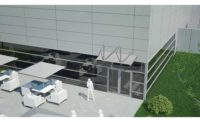 MC Industrial Weather and technological challenges make the $905-million plant daunting.
|
Neither rain, nor snow nor sleet could delay the start of slipforming on the first two silos for what will be the largest cement plant in the U.S.
A Nov. 30 ice storm that knocked out power to a half-million customers in Illinois and Missouri raked Ste. Genevieve County, 55 miles south of St. Louis, where contractors were preparing to place concrete for the first major structures of Holcim (US) Inc.’s $905-million cement plant. The weather slowed work and forced the contractor into weekend shifts, but the first concrete was placed on schedule Dec. 4.
A joint venture of MC Industrial, St. Louis, and T.E. Ibberson Co., Minneapolis, now is raising twin 275-ft-tall raw-mill silos with 60-ft inside diameter that will store freshly quarried crushed limestone. Round-the-clock shifts will complete placement of 6,015 cu yd of concrete for them in 16 days, contractor officials say. Holcim awarded the lump-sum, competitively bid, design-build contract in August for 13 silos for the 4-million-tonne-per-year cement plant. The value of the contract was not disclosed.
Workers will begin placing concrete in February for one of two partially post-tensioned clinker silos, each 150 ft in diameter and 207 ft tall. Concrete for the second clinker silo and a 40-ft-diameter, 207-ft-tall silo will begin in March, says Will Chipley, project manager. In April and May, concrete will be poured for twin “four-packs” of 79-ft-diameter, 275-ft-tall silos to hold cement. Each will be fitted inside with 24, 90-ft-long precast panels to form an inverted cone at the bottom of the storage. Silo construction, with more than 90,000 cu yd of concrete, is expected to be done in February 2008.
 Holcim (US) Inc. |
Preparations were in full swing at the end of November when the storm struck. Heavy morning rain on Nov. 30 turned to icy rain by midafternoon and sleet by 6 p.m., says Chipley. Temperatures remained in the low 30s long after the storm had passed. Concrete placement began Monday morning with the temperature at 8° F. “The batch plant had to steam the aggregate,” he says. But work has progressed steadily since then.
A batch plant operated by St. Louis- based Metro Materials six miles away in Bloomsdale, Mo., is supplying an average of 30 cu yd of concrete per hour. The contractor is using 60 propane radiant heaters to warm the outside of the silo, which is protected by 20-ft concrete blankets. The interior air is warm enough to make other measures unnecessary, he says. The forecast at ENR press time is for fairly stable weather, with temperatures between high 40s and high 20s for the remainder of the pour. “These are good days,” says Chipley.
But challenges lie ahead. Among the greatest are the two clinker silos. “I’ve been told these are the largest silo slips in North America,” Chipley says. Each 150-ft-diameter silo has another 22-ft-diameter silo inside to help support the roof, which will be cast-in-place concrete.
The outer silos will be 2 ft 8 in. thick at the bottom and 1 ft 2 in. at the top. The raw-mill silos now being slipformed will have a 5-ft-thick bin bottom at 100 ft, where the wall thickness will be stepped down from 2 ft to 1 ft. Six triangular columns, 9 ft per side, will support the bin bottom, with the space around them occupied by mechanical equipment.
Perhaps the greatest challenge will be placement of the inverted-cone panels. Still in design, they will be about 2 ft 8 in. thick, Chipley says. Tendons inside the base of the vertical silo wall will hold them in place until the last of the 24 panels is inserted, holding them as a keystone. They will then be held together with cast-in-place reinforced concrete.


Post a comment to this article
Report Abusive Comment